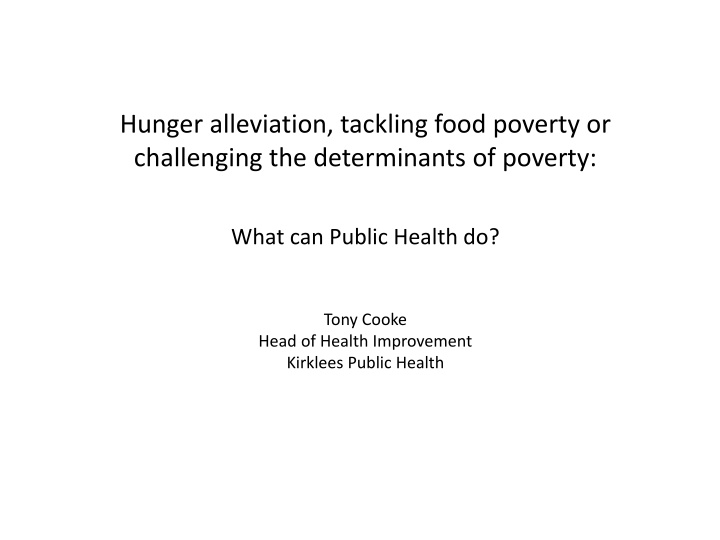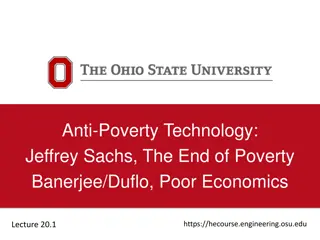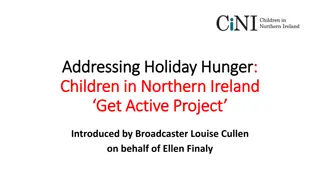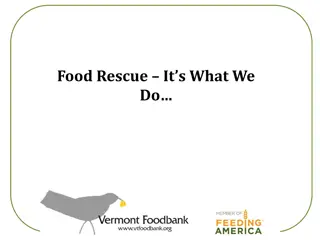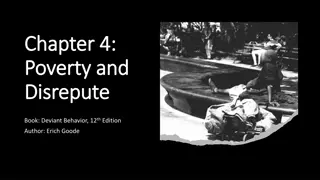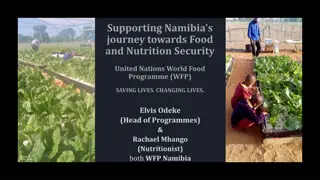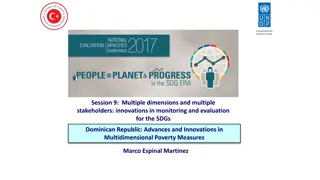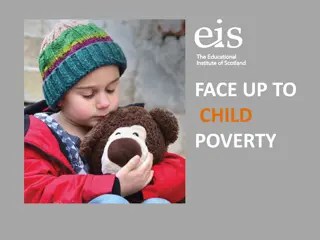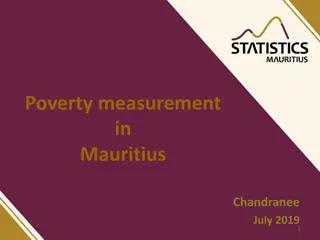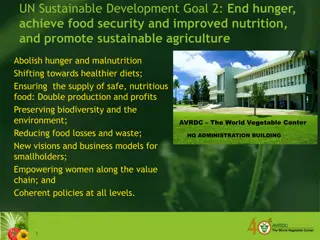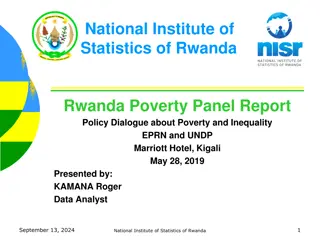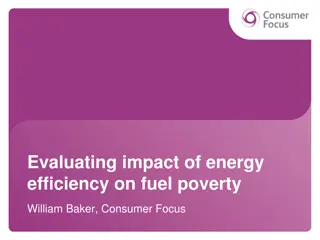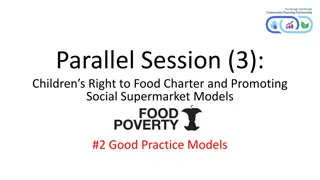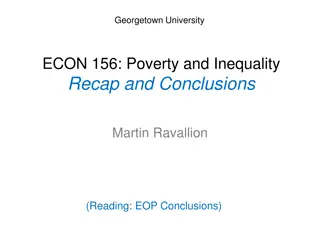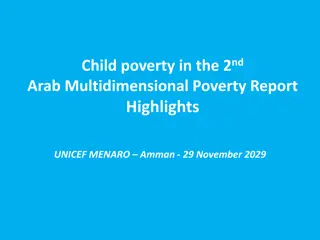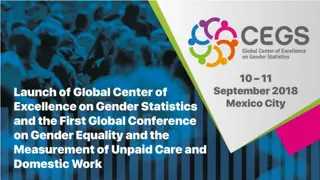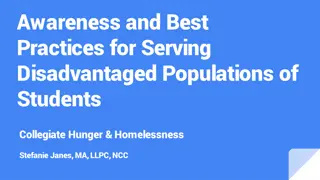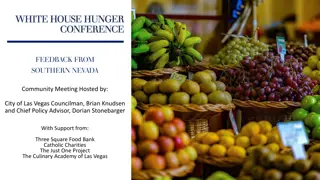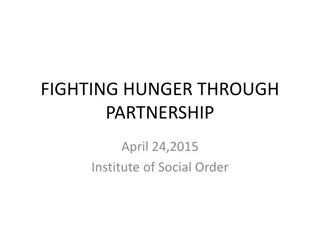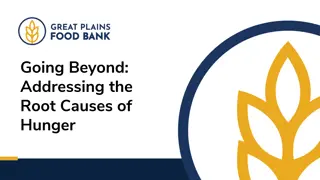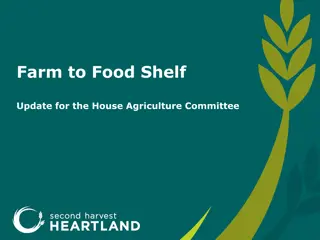Addressing Food Poverty and Hunger: Public Health Initiatives
Public Health plays a crucial role in combating food poverty by addressing factors such as lack of access to healthy food, inadequate cooking skills, and economic limitations. Issues like irregular work schedules, limited nutritious food choices, and stigma associated with food insecurity further contribute to the challenge. By focusing on interventions such as promoting healthy eating habits, improving food access, and advocating for policy changes, Public Health can make significant strides in alleviating hunger and improving food security in communities.
Download Presentation

Please find below an Image/Link to download the presentation.
The content on the website is provided AS IS for your information and personal use only. It may not be sold, licensed, or shared on other websites without obtaining consent from the author.If you encounter any issues during the download, it is possible that the publisher has removed the file from their server.
You are allowed to download the files provided on this website for personal or commercial use, subject to the condition that they are used lawfully. All files are the property of their respective owners.
The content on the website is provided AS IS for your information and personal use only. It may not be sold, licensed, or shared on other websites without obtaining consent from the author.
E N D
Presentation Transcript
Hunger alleviation, tackling food poverty or challenging the determinants of poverty: What can Public Health do? Tony Cooke Head of Health Improvement Kirklees Public Health
Food poverty is the inability to afford or to have access to food to make up a healthy diet (Department of Health) Food poverty is worse diet, worse access, worse health, higher percentage of income on food, and less choice from a restricted range of foods. (Tim Lang, Professor of Food Policy at City University, London)
Shift work and irregular hours Lack of cooking skills & confidence Low income and less healthy eating behaviours Less opportunity for physical activity and large number of takeaways in deprived areas . Space for preparing and eating as a family Lack of exposure to sunlight = Vit D deficiency Lack of cooking utensils Access to affordable healthy food Irregular meal times Psycho-social stress and stigma Lack of cooking in the home. Families rarely sit down together to eat a meal Lower consumption of fruit and veg and a higher intake of fats, sugars + salt. Problems with overweight and underweight Food behaviour linked to other health behaviours: physical activity ,alcohol, smoking Food budget will often be reduced before other household outgoings Food poverty and diet of people on low incomes
Increased numbers accessing food banks Increased under nutrition Increase in numbers overweight and obese Perfect storm Population wide people are eating less nutritious food Starker inequalities in income, stark inequalities in diets and food skills In Kirklees lower income groups less confident at cooking from scratch Bad food can cost less per calorie It is also more accessible/profitable
20,840 21% 42,800 Child Poverty 16% 22,040 Working age Poverty 33% Pensioner Poverty Poverty in Kirklees
Cost of living increases 2008 - 2012 27% 25% 18% Minimum Income basket Food Energy Annual benefits uprating 2008 - 2012 Annual benefits uprating 2013 onwards 2.2% 2.2% 1% Work related benefits uprating Disabled people and pensioners uprating Universal uprating
The biggest losers bn Some households and individuals, notably sickness and disability claimants, will be hit by several different elements of the reforms. 5.0 4.5 4.0 3.5 3.0 2.5 2.0 1.5 1.0 0.5 0.0 Incapacity Benefits Tax Credits 1% up-rating of most working-age benefits Housing Benefit reforms average loss per affected household/individual 810 average loss per affected household/individual 3,480
Discussions in Kirklees All people in poverty are at risk of food poverty but individual circumstances are different Some people are more resilient Some have stronger communities/social capital Some grow their own food or have an allotment Benefit sanctions are an exception Most people on benefits do not attend food banks but most people sanctioned do Increasing numbers are sanctioned
The Kirklees response: Proportionate universalism Narrative for change: the food charter and strategy A population level approach where possible Food for Life Partnership in schools to improve quality and uptake of meals Silver catering award provider supplies food to all but one Kirklees school Projects to increase food growing across Kirklees National Child Measurement Programme Healthy Choice Award targets take-aways and restaurants Recycling and food waste projects Better procurement promotes more local jobs Targeted services where necessary 40 growing sites in areas of multiple deprivation, focus on social housing, disabilities, LTCs Settings based approach to target hospitals, early years and care settings, using FFLP and development of similar standards to support sustainable food Food banks+ i.e. skills training, cook and eat sessions and (planned) growing sites
Questions for consideration Do we need to make a clear distinction between hunger, food poverty and poverty? Should we focus on alleviation of hunger, improvements to diet/nutrition or both? How to engage with public health teams to address food poverty? How can public health engage other partners to address food poverty? What are the consequences of food poverty? Which areas can public health address? Focus on low / medium input, high impact Can local authorities develop systematic strategies to address health inequalities including food poverty and poverty more generally How can they join wider lobbying efforts around poverty and its impact What action can you commit to taking forward when you get back to your City/town?
Whats happened is that the level of income inequality has been increasing. And by that we mean that the very rich have been getting more and more money, and people lower down, have been getting less. Michael Marmot, 2013
